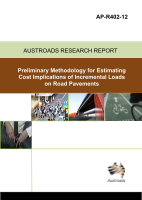Asset Management

- Publication no: AP-R402-12
- ISBN: 978-1-921991-20-2
- Published: 7 March 2012
- PDF (free) Download
This report documents the development of a preliminary set of load-wear-cost (LWC) relationships as a basis for estimating the short-run marginal road wear cost (SRMC) and long-run marginal road wear cost (LRMC) for the main road types comprising Australia's sealed road network. It also deals with the LWC relationships were based on a pavement life-cycle costing analysis of each sealed road type using the Freight Axe Mass Limits Investigation Tool (FAMLIT) for three main pavement types (sealed unbound granular, GN, asphalt, AC, and cement stabilised, CS) considering six typical axle groups (single axle single tyres, SAST, single axle dual tyres, SADT, tandem axle single tyre, TAST, tandem axle dual tyre, TADT, triaxle dual tyres, TRDT, and quad axle dual tyres, QADT) loaded in 0.25 tonne load increments from the axle group tare weight up to well beyond the general mass limits (GML).
- 1. INTRODUCTION
- 1.1. Project Scope
- 1.2. Pavement Life-cycle Maintenance Activities
- 1.3. Effects of Increasing Traffic Loading on Pavement Maintenance Costs
- 1.4. Marginal Costs of Road Damage
- 2. APPROACH AND ASSUMPTIONS FOR DEVELOPING LOAD-WEAR-COST RELATIONSHIPS
- 2.1. Approach for Developing LWC Relationships
- 2.2. Assumptions for Determining the Components of Road Wear Cost
- 3. LIFE-CYCLE COSTING ANALYSIS TOOL
- 3.1. FAMLIT Modelling Framework
- 3.2. Calibration of FAMLIT Models
- 4. ASSESSMENT PARAMETERS
- 4.1. Network Matrix
- 4.2. Loading Scenarios
- 4.2.1. Traffic Loading for Flexible Pavements
- 4.2.2. Traffic Loading for Concrete Pavements
- 4.3. FAMLIT Analysis Parameters
- 5. LOAD-WEAR-COST (LWC) RELATIONSHIPS FOR ALL PAVEMENT TYPES
- 5.1. Determining LWC Relationships for the Pavement Types
- 5.2. Developing SRMC Relationships (Phase 1)
- 5.3. Developing LWC Relationships with Axle Group Loads (Phase 2)
- 5.3.1. Influence of Deterioration Models on EAUC Estimates
- 5.3.2. Influence of Different Axle Groups on EAUC Estimates
- 5.3.3. Variations in EAUC and Axle Load Relationships by Pavement Type
- 5.3.4. Variations in EAUC by Road Hierarchy
- 5.4. Developing LWC Relationships with SARs (Phase 2)
- 5.4.1. EAUC and SAR Relationships for Alternative Pavement Deterioration Models
- 5.4.2. EAUC and SAR Relationships for Different Axle Groups
- 5.4.3. Variations in EAUC and SAR Relationships by Road Type
- 5.5. Developing Marginal Cost Relationships (Phase 2)
- 5.5.1. Introduction
- 5.5.2. Marginal Cost Estimates
- 6. PARAMETRIC STUDY OF THE INFLUENCE OF THE INPUTS TO THE FAMLIT ANALYSIS
- 6.1. Introduction
- 6.2. Parametric Factorial
- 6.3. Parametric Study Outputs
- 6.4. Summary of Sensitivity Testing
- 7. INFLUENCE OF TYRE TYPE WIDTH AND OTHER EFFECTS ON LWC
- 7.1. Introduction
- 7.2. Current State of Practice
- 7.3. Predicted Influence on LWC
- 8. DISCUSSION OF LWC AND SRMC RELATIONSHIPS (PHASE 1)
- 8.1. The LWC Relationships
- 8.2. The MC Relationships
- 8.2.1. MC Using Average c/SAR-km of Axle Groups on Each Road Type
- 8.2.2. MC Using c/tonne-km for Each Axle Group
- 8.3. Factors Influencing the MC Estimates
- 9. SUMMARY
- 9.1. Phase 1 – Summary
- 9.1.1. MC Estimation
- 9.1.2. MC Estimation Outcomes
- 9.2. Phase 2 – Summary
- 9.2.1. Parametric Study of Factors Impacting on Estimation of MC
- 9.2.2. LWC Relationships – General
- 9.2.3. LWC Relationships of Three Additional Axle Groups
- 9.2.4. Impact of Deterioration Modelling on LWC Relationships
- 9.2.5. Marginal Costs of Road Wear Estimation
- 9.3. Future Work
